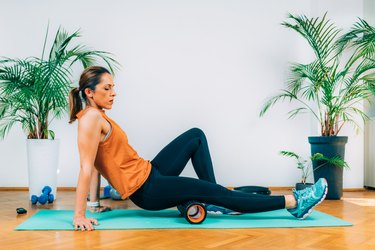

A little muscle soreness after a tough workout is normal. After all, you just really challenged your muscles. But the last thing you want is muscle soreness to get in the way of your body's recovery (and future workouts).
Luckily, there are a handful of pretty simple steps you can take each day to help fight tension — and they're physical therapist-approved! Read on to learn the five things physical therapists do daily to ease muscle discomfort and why they're so effective.
Video of the Day
Video of the Day
1. Drink Plenty of Water
It can't be said enough: Hydrate, hydrate, hydrate. Sipping on H2O throughout the day is one of the top tools Jereme Schumacher, DPT, a California-based physical therapist, uses to fight muscle soreness.
"Proper daily water intake improves fluid dynamics in our body, which helps remove the waste in our muscles causing soreness," he says. "I compare this to a river: If there isn't adequate water flow, the water becomes dirty. But if there is a strong current, the river is constantly filtering out all the bad stuff."
Dehydration can slow your rate of recovery, making it harder for your muscles to heal and repair after a tough workout, according to an August 2020 study conducted by the Gatorade Sports Science Institute (GSSI). As a result, you can feel stiff or sore for days after training.
Everyone has their own personal hydration needs, so there's no one standard amount of water you should drink. People who are physically active need a higher amount of fluids daily, often 3 to 4 liters, according to the GSSI.
But a good way to make sure you're hydrating properly is to check your urine after you use the bathroom, according to the Cleveland Clinic. Ideally, your pee should be a pale, practically clear color throughout the day.
2. Do Body-Weight Exercises
It might sound counterproductive, but moving your sore muscles can actually help them feel better more quickly, Schumacher says. That's why he likes to incorporate some muscle-specific movement when he's feeling extra achy.
Generally, which muscles become sore depends on the exercises you did during your previous workout, he says. So, if you did a heavy squat workout, for example, you're probably feeling a little tight in your glutes, quads and hamstrings. To combat that discomfort, Schumacher recommends low-intensity exercises that focus on these muscles, like air squats.
Moving your sore muscles might not feel too great initially, but after a few rounds of low-intensity, body-weight exercises, you boost blood flow to those muscles and actually feel them loosen up, he says.
"The name of the game when dealing with muscle soreness is blood flow," Schumacher says. "Increased blood flow will flush out your muscles, bringing in proper nutrients to rebuild our muscles back stronger."
3. Stick to Low-Intensity Cardio
When she's in need of muscle recovery, Melissa Garcia, DPT, CSCS, a Washington-based physical therapist, loves to do some low-intensity cardio. Walking outside or going on a leisurely bike ride boosts blood flow to your body, reducing your overall soreness.
But the key here is to keep it low-impact and low-intensity, she says. The last thing you want to do is make your muscles even more fatigued by jumping into a sprint session. Throw on a relaxing playlist or podcast, grab your sneakers and focus on just moving your body, rather than getting a workout in.
4. Foam Roll
Alleviating tightness and soreness with a foam roller is another way Schumacher likes to promote blood flow and muscle recovery. Foam rolling works by sending messages to your nervous system and muscles to relax. He especially likes this strategy after a leg day when his larger muscle groups (like his quads or hamstrings) feel extra achy.
While you can foam roll at any time, doing it post-workout is ideal. Foam rolling after an intense workout can actually help reduce delayed-onset muscle soreness (DOMS), according to a small January 2015 study in the Journal of Athletic Training.
Depending on which area of your body you want to target, sit or lie down on the foam roller with the muscle on top of it. Apply moderate, steady pressure to the area for 30 to 60 seconds, moving up and down the length of the muscle. (FYI, foam rolling should never be painful so if you feel pain, stop immediately.)
But if that window of opportunity has already passed you by, you can still benefit from foam rolling. Even just 10 to 15 minutes can help loosen up any tight areas across your body.
5. Increase Protein Intake
When his muscles are especially sore, Schumacher prioritizes protein in his diet to help encourage faster recovery.
Every time you work out, you create little tears in your muscle fibers. Your body repairs these tears, growing stronger muscles in the process. Protein acts as a building block for muscle development, he says. That's why it's so important to eat enough of it when your muscles are feeling a little achy.
According to the American Council on Exercise, you should aim to get 15 to 25 grams of protein and one to two grams/kg (body weight) of carbs per hour of exercise. So if you worked out for an hour and weigh 150 pounds, you should get 15 to 25 grams of protein and 68 to 136 grams of carbs daily.
Although increasing your protein won't provide immediate relief, it does help speed the recovery process over time.
Related Reading
- Gatorade Sports Science Institute: "Dehydration and Exercise-Induced Muscle Damage: Implications for Recovery"
- Cleveland Clinic: "Dehydration"
- Journal of Athletic Training: "Foam Rolling for Delayed-Onset Muscle Soreness and Recovery of Dynamic Performance Measures"
- Gatorade Sports Science Institute: Dietary Water and Sodium Requirements for Active Adults"
- American Council on Exercise: "Meal Timing: What and When to Eat for Performance and Recovery"